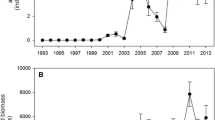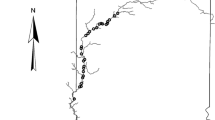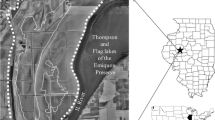Abstract
Changes in species dominance may drive regime shifts because dominant biotic feedbacks reflect functional traits of a community. Changes in species dominance has been documented by a 25-year fish community dataset encompassing six reaches of the Upper Mississippi and Illinois Rivers. Specifically, common carp (Cyprinus carpio) abundance has declined across all reaches, whereas silver carp (Hypophthalmichthys molitrix) and bighead carp (Hypophthalmichthys nobilis) have increased in abundance in the southern three reaches. To test whether signals in the data were consistent with regime transitions, changes in body-size patterns and trends in functional biomass and variance of functional biomass of the fish community were assessed. I further explored biomass thresholds relative to transitions. Shifts in body-size aggregations and trends in functional biomass support hypotheses that transitions from common carp dominance to a more functional diverse community represent alternate regimes. Results indicate such transitions occurred in the early 2000s for the two most northern reaches, and that the third most northern reach is nearing this transition. In the southern reaches, results indicate that transitions from common carp dominance to silver and bighead carp dominance also represent alternate regimes. Regime transitions support biomass thresholds between 8000 and 10,000 g per unit of day electrofishing effort of common carp and between 20 and 2000 g per unit effort in silver and bighead carp. Consistencies across reaches with similar dominance patterns provide support that reinforcing feedbacks, unique to the functional attributes of the dominant species, occur at similar biomass levels. Building knowledge of such feedback mechanisms is imperative to effectively manage for desired regimes.


Adapted from Bouska et al. (2020). Picture credits: Steve DeLain, Minnesota Department of Natural Resources, and Dave Ostendorf, Missouri Department of Conservation







Similar content being viewed by others
References
Akaike H (1974) A new look at the statistical model identification. IEEE Trans Autom Control 19:716–723
Anderies JM, Janssen MA, Walker BH (2002) Grazing management, resilience, and the dynamics of a fire-driven rangeland system. Ecosystems 5:23–44
Angeler DG, Allen CR, Barichievy C, Eason T, Garmestani AS, Graham NAJ, Granholm D, Gunderson LH, Knutson M, Nash KL, Nelson RJ, Nystrom M, Spanbauer TL, Stow CA, Sundstrom SM (2016) Management applications of discontinuity theory. J Appl Ecol 53:688–698
Bajer PG, Sullivan G, Sorensen PW (2009) Effects of a rapidly increasing population of common carp on vegetative cover and waterfowl in a recently restored Midwestern shallow lake. Hydrobiologia 632:235–245
Bajer PG, Beck MW, Cross TK, Koch JD, Bartodziej WM, Sorensen PW (2016) Biological invasion by a benthivorous fish reduced the cover and species richness of aquatic plants in most lakes of a large North American ecoregion. Glob Change Biol 22:3937–3947
Barko VA, Ickes BS, Herzog DP, Hrabik RA, Chick JH, Pegg MA (2005) Spatial, temporal, and environmental trends of fish assemblages within six reaches of the Upper Mississippi River System. LTRMP Technical Report 2005-T002. U.S. Geological Survey, Upper Midwest Environmental Science Center, La Crosse, Wisconsin, USA
Benaglia T, Chauveau D, Hunter DR, Young DS (2009) mixtools: An R package for analyzing finite mixture models. J Stat Softw 32:1–29
Biggs R, Peterson GD, Rocha JC (2018) The Regime Shifts Database: a framework for analyzing regime shifts in social-ecological systems. Ecol Soc 23:9
Bouska KL (2018) Discontinuities and functional resilience of large river fish assemblages. Ecosphere 9:e02351
Bouska WW, Glover D, Bouska KL, Garvey JE (2017) A refined electrofishing technique for collecting Silver Carp: implications for management. N Am J Fish Manag 37:101–107
Bouska KL, Houser JN, De Jager NR, Van Appledorn M, Rogala JT (2019) Applying concepts of general resilience to large river ecosystems: a case study from the Upper Mississippi and Illinois rivers. Ecol Indic 101:1094–1110
Bouska KL, Houser JN, De Jager NR, Drake DC, Collins SF, Gibson-Reinemer DK, Thomsen MA (2020) Conceptualizing alternate regimes in a large floodplain-river ecosystem. J Environ Manag 264:110516
Bray JR, Curtis JT (1957) An ordination of the upland forest communities of southern Wisconsin. Ecol Monogr 27:326–349
Burdis RM, Delain S, Lund EM, Moore MJC, Popp WA (2020) Decadel trends and ecological shifts in backwater lakes of a large floodplain river: Upper Mississippi River. Aquat Sci 82:27
Casselman JM, Penczak T, Carl L, Mann RHK, Holcik J, Woitowich WA (1990) An evaluation of fish sampling methodologies for large river systems. Polskie Archiwum Hydrobiologii 37:521–551
Chen YH, Simons DB (1986) Hydrology, hydraulics, and geomorphology of the Upper Mississippi River System. Hydrobiologia 136:5–19
Chick JH, Pegg MA (2001) Invasive carp in the Mississippi River basin. Science 292:2250–2251
Chick JH, Gibson-Reinemer DK, Soeken-Gittinger L, Casper AF (2019) Invasive silver carp is empirically linked to declines of native sport fish in the Upper Mississippi River system. Biol Invasions 22:723–734
Crowder LB, Mcdonald ME, Rice JA (1987) Understanding recruitment of Lake-Michigan fishes—the importance of size-based interactions between fish and zooplankton. Can J Fish Aquat Sci 44:141–147
De Robertis A, Ryer CH, Veloza A, Brodeur RD (2003) Differential effects of turbidity on prey consumption of piscivorous and planktivorous fish. Can J Fish Aquat Sci 60:1517–1526
DeBoer JA, Anderson AM, Casper AF (2018) Multi-trophic response to invasive silver carp (Hypophthalmichthys molitrix) in a large floodplain river. Freshw Biol 63:597–611
Dionne M, Folt CL (1991) An experimental-analysis of macrophyte growth forms as fish foraging habitat. Can J Fish Aquat Sci 48:123–131
Domaizon I, Devaux J (1999) Impact of moderate silver carp biomass gradient on zooplankton communities in a eutrophic reservoir. consequences for the use of silver carp in biomanipulation. C R Acad Sci Ser Iii Sci Vie Life Sci 322:621–628
Fischer J, Lindenmayer DB, Montague-Drake R (2008) The role of landscape texture in conservation biogeography: a case study on birds in south-eastern Australia. Divers Distrib 14:38–46
Fletcher CM, Collins SF, Nannini MA, Wahl DH (2019) Competition during early ontogeny: effects of native and invasive planktivores on the growth, survival, and habitat use of bluegill. Freshw Biol 64:697–707
Folke C, Carpenter S, Walker B, Scheffer M, Elmqvist T, Gunderson L, Holling CS (2004) Regime shifts, resilience, and biodiversity in ecosystem management. Annu Rev Ecol Evol Syst 35:557–581
Giblin SM (2017) Identifying and quantifying environmental thresholds for ecological shifts in a large semi-regulated river. J Freshw Ecol 32:433–453
Gibson-Reinemer DK, Chick JH, Vanmiddlesworth TD, Vanmiddlesworth M, Casper AF (2017) Widespread and enduring demographic collapse of invasive common carp (Cyprinus carpio) in the Upper Mississippi River System. Biol Invasions 19:1905–1916
Glazier DS (2013) Log-transformation is useful for examining proportional relationships in allometric scaling. J Theor Biol 334:200–203
Goffaux D, Grenouillet G, Kestemont P (2005) Electrofishing versus gillnet sampling for the assessment of fish assemblages in large rivers. Arch Fur Hydrobiol 162:73–90
Graeb BDS, Dettmers JM, Wahl DH, Caceres CE (2004) Fish size and prey availability affect growth, survival, prey selection, and foraging behavior of larval yellow perch. Trans Am Fish Soc 133:504–514
Grenouillet G, Pont D, Seip KL (2002) Abundance and species richness as a function of food resources and vegetation structure: juvenile fish assemblages in rivers. Ecography 25:641–650
Hartigan JA, Hartigan PM (1985) The dip test of unimodality. Ann Stat 13:70–84
Hillebrand H, Bennett DM, Cadotte MW (2008) Consequences of dominance: a review of evenness effects on local and regional ecosystem processes. Ecology 89:1510–1520
Holling CS (1992) Cross-scale morphology, geometry, and dynamics of ecosystems. Ecol Monog 62:447–502
Ickes BS, Sauer JS, Rogala JT (2014) Monitoring rationale, strategy, issues, and methods: UMRR-EMP LTRMP fish component. A program report submitted to the U.S. Army Corps of Engineers’ Upper Mississippi River Restoration-Environmental Management Program, Program Report LTRMP 2014–P001a
Jackson ZJ, Quist MC, Downing JA, Larscheid JG (2010) Common carp (Cyprinus carpio), sport fishes, and water quality: ecological thresholds in agriculturally eutrophic lakes. Lake Reserv Manag 26:14–22
Juggins S (2017) 'rioja': Analysis of quaternary science data, R package version (0.9–21). New Castle, UK.
Lohr SL (1999) Sampling: design and analysis. Pacific Grove, California, Brooks/Cole
Nash KL, Allen CR, Angeler DG, Barichievy C, Eason T, Garmestani AS, Graham NAJ, Granholm D, Knutson M, Nelson RJ, Nystrom M, Stow CA, Sundstrom SM (2014a) Discontinuities, cross-scale patterns, and the organization of ecosystems. Ecology 95:654–667
Nash KL, Allen CR, Barichievy C, Nystrom M, Sundstrom S, Graham NAJ (2014b) Habitat structure and body size distributions: cross-ecosystem comparison for taxa with determinate and indeterminate growth. Oikos 123:971–983
Norberg J (2004) Biodiversity and ecosystem functioning: a complex adaptive systems approach. Limnol Oceanogr 49:1269–1277
Nystrom M, Graham NAJ, Lokrantz J, Norstrom AV (2008) Capturing the cornerstones of coral reef resilience: linking theory to practice. Coral Reefs 27:795–809
O'Hara M, Ickes BS, Gittinger E, Delain S, Dukerschein T, Pegg M, Kalas J (2007) Development of a life history database for Upper Mississippi River fishes. LTRMP Technical Report 2007-T001. U.S. Geological Survey, Upper Midwest Environmental Sciences Center, La Crosse, Wisconsin
Oksanen J, Guillaume Blanchet F, Friendly M, Kindt R, Legendre P, Mcglinn D, Minchin PR, O'Hara RB, Simpson GL, Solymos P, Stevens MHH, Szoecs E, Wagner H (2009) vegan: Community ecology package. R package version 2.5–5
Olson MH (1996) Ontogenetic niche shifts in largemouth bass: variability and consequences for first-year growth. Ecology 77:179–190
Parkos JJ, Santucci VJ, Wahl DH (2003) Effects of adult common carp (Cyprinus carpio) on multiple trophic levels in shallow mesocosms. Can J Fish Aquat Sci 60:182–192
Pendleton RM, Schwinghamer C, Solomon LE, Casper AF (2017) Competition among river planktivores: Are native planktivores still fewer and skinnier in response to the silver carp invasion? Environ Biol Fishes 100:1213–1222
Pflieger WL (1997) The fishes of Missouri, Missouri Department of Conservation
R Core Team (2019) R: A language and environment for statistical computing. R Foundation for Statistical Computing, Vienna
Ratcliff EN, Gittinger EJ, O’Hara TM, Ickes BS (2014) Long term resource monitoring program procedures: fish monitoring, 2nd edn. A program report submitted to the U.S. Army Corps of Engineers' Upper Mississippi River Restoration-Environmental Management Program, Program Report LTRMP 2014-P001
Rice JA, Crowder LB, Holey ME (1987) Exploration of mechanisms regulating larval survival in Lake-Michigan bloater—a recruitment analysis based on characteristics of individual larvae. Trans Am Fish Soc 116:703–718
Roberts CP, Allen CR, Angeler DG, Twidwell D (2019) Shifting avian spatial regimes in a changing climate. Nat Clim Change 9:562
Scheffer M, Carpenter S, Foley JA, Folke C, Walker B (2001) Catastrophic shifts in ecosystems. Nature 413:591–596
Schmitz OJ (2004) Perturbation and abrupt shift in trophic control of biodiversity and productivity. Ecol Lett 7:403–409
Spanbauer TL, Allen CR, Angeler DG, Eason T, Fritz SC, Garmestani AS, Nash KL, Stone JR, Stow CA, Sundstrom SM (2016) Body size distributions signal a regime shift in a lake ecosystem. Proc R Soc B Biol Sci 283:20160249
Suding KN, Gross KL, Houseman GR (2004) Alternative states and positive feedbacks in restoration ecology. Trends Ecol Evol 19:46–53
Sundstrom SM, Angeler DG, Barichievy C, Eason T, Garmestani A, Gunderson L, Knutson M, Nash KL, Spanbauer T, Stow C, Allen CR (2018) The distribution and role of functional abundance in cross-scale resilience. Ecology 99:2421–2432
Tukey JW (1949) Comparing individual means in the analysis of variance. Biometrics 5:99–114
Weber MJ, Brown ML (2009) Effects of common carp on aquatic ecosystems 80 years after 'Carp as dominant'; ecological insights for fisheries management. Rev Fish Sci 17:524–537
Werner EE, Hall DJ (1988) Ontogenetic habitat shifts in bluegill—the foraging rate predation risk trade-off. Ecology 69:1352–1366
Whitledge GW, Knights B, Vallazza J, Larson J, Weber MJ, Lamer JT, Phelps QE, Norman JD (2019) Identification of bighead carp and silver carp early-life environments and inferring lock and dam 19 passage in the Upper Mississippi River: insights from otolith chemistry. Biol Invasions 21:1007–1020
Winemiller KO, Rose KA (1992) Patterns of life-history diversification in North-American fishes—implications for population regulation. Can J Fish Aquat Sci 49:2196–2218
Wolfe MD, Santucci VJ, Einfalt LM, Wahl DH (2009) Effects of common carp on reproduction, growth, and survival of largemouth bass and bluegills. Trans Am Fish Soc 138:975–983
Acknowledgements
Appreciation is given to the Long Term Resource Monitoring affiliated scientists and field stations that have developed and maintained a high-quality monitoring program, and the individual biologists who have collected the fisheries data that this work relied upon. I thank Jeff Houser and Stephen Winter for constructive feedback of an earlier draft. This work was funded as part of the U.S. Army Corps of Engineers’ Upper Mississippi River Restoration Program. Any use of trade, firm, or product names is for descriptive purposes only and does not imply endorsement by the U.S. Government.
Author information
Authors and Affiliations
Corresponding author
Additional information
Publisher's Note
Springer Nature remains neutral with regard to jurisdictional claims in published maps and institutional affiliations.
Electronic supplementary material
Below is the link to the electronic supplementary material.
Rights and permissions
About this article
Cite this article
Bouska, K. Regime change in a large-floodplain river ecosystem: patterns in body-size and functional biomass indicate a shift in fish communities. Biol Invasions 22, 3371–3389 (2020). https://doi.org/10.1007/s10530-020-02330-5
Received:
Accepted:
Published:
Issue Date:
DOI: https://doi.org/10.1007/s10530-020-02330-5




